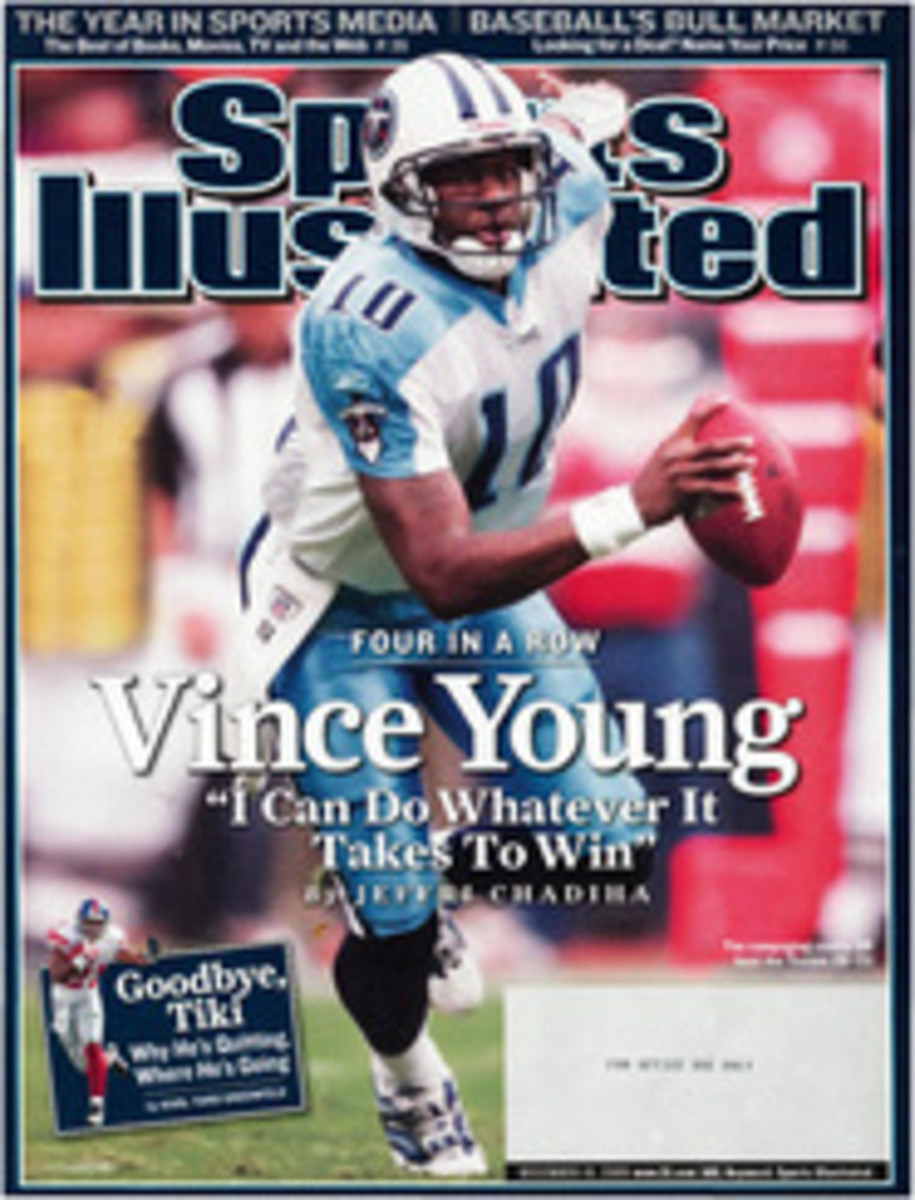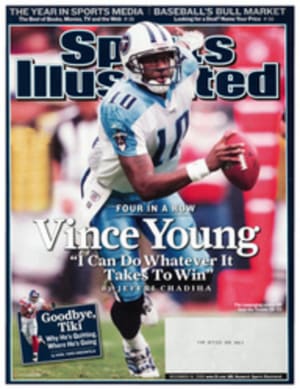
A New Light
In their landmark book, Game of Shadows, San Francisco Chronicle reporters Mark Fainaru-Wada and Lance Williams describe how Giants slugger Barry Bonds, pumped full of steroids and arrogance, reacted when his inner circle failed to respond quickly enough to his demands. "Did I f------ stutter?" Using cold facts instead of a cold snarl, Shadows returns the treatment to Bonds and other scoundrels in the Golden Age of Cheating in sports. The book is in-your-face reportage. It does not stutter.
In a lawyered-up world, Shadows's dead-solid certainty and its disdain for shopworn "allegedlys" may be the most remarkable of its many virtues. Fainaru-Wada and Williams's dismantling of Victor Conte's BALCO empire produces the richest catalog of performance-enhancing drug use ever, and the account is rendered in the clear voice of a history treatise. In fact, that's essentially what it is. Like it or not, it is the story of our times.
That history is unkind to its subjects. The reputations of the athletes in Conte's orbit--Bonds, the sprinters Tim Montgomery, Kelli White and Marion Jones, the baseball players Gary Sheffield and Jason Giambi, the football player Bill Romanowski--were devastated by Shadows. Their public ruin began Sept. 3, 2003, when federal agents raided BALCO, the Bay Area lab run by Conte, who played the scheming villain right down to the expertly trimmed mustache. Two weeks later a tipster told Fainaru-Wada, an investigative journalist working on a campaign-finance project, and Williams, another investigative reporter schooled on police and court beats, that the raid concerned a link between steroids and athletes. The Chronicle, making what has become a too-rare commitment to investigative journalism, put Fainaru-Wada and Williams on the story for the next two years.
The reporters rewarded their paper's initiative with the kind of relentless work that produced Watergate. Fainaru-Wada and Williams exposed a cheat-or-lose program that, while perfected by Conte, wasn't unique among elite athletes. In asking the questions that pro leagues, fans and much of the media dared not ask, the reporters also nailed how drugs have changed our games and exposed the seemingly insurmountable gap between the cheaters and the testers. The braggadocio of Greg Anderson, Bonds's trainer, who is caught on a 2003 recording saying that Bonds's drugs go undetected in baseball's tests, is the voice of sports' soulless generation.
President Bush called the reporters' work "a service." The irony is that it may land them in jail. The reporters, upon refusing a judge's request to reveal the source who provided them with grand jury testimony, were found in contempt and sentenced to as long as 18 months in prison--more than the BALCO felons served cumulatively. (They're free pending a Feb. 12 appeal.) The unfortunate legacy of Shadows: Cheaters do win; those who expose them sometimes suffer.
THE BROW BEAT
HIGH How would Kant, who tried to define beauty, feel about a perfectly turned double play? He'd love it, says Hans Ulrich Gumbrecht. The Stanford comparative literature professor's In Praise of Athletic Beauty is a thought-provoking--and academically rigorous--defense of the grace and aesthetic worth of sports.
LOW It's an autobiography, but My Life in and out of the Rough reads more like a long country ballad. Drinking, gambling, smoking, sex--John Daly is brutally honest (hyberbolic?) about his foibles, and the pages go faster than a pack of Big John's Marlboros.
Heavy Reading
FINALLY, a book you can judge by its cover. The title of XL: Forty Years of the Super Bowl couldn't be more fitting. At 850 pages and 88 pounds, the latest coffee-table--make that banquet-table--tome in British publisher Kraken's Opus series is nearly as long as Bill Walsh's playbook and as heavy as Garo Yepremian. The leather-bound, gilt-edged history (available at krakenopus.com) is a treasure for serious fans. Serious spenders, too: XL costs $4,000--$40,000 for one of 400 copies signed by every living Super Bowl MVP.
From SI
BASEBALL, more than any other sport, is intertwined with its past, and the game's story is presented in SPORTS ILLUSTRATED's The Baseball Book. It features more than 400 photos and celebrated stories by SI writers--including Frank Deford, George Plimpton, Rick Reilly and Tom Verducci--since the magazine was born in 1954. The centerpiece is a photo illustration of SI's Alltime All-Star Team--the game's greatest players gathered in one dugout. Different dream teams are celebrated in SI's Great Football Writing, an anthology of the best articles on America's game, and in Exposure, a behind-the-scenes look at the 2005 reunion of eight Swimsuit Issue cover models.
11/10 >> DRAMA BEAUTIFUL OHIO, PRODUCED BY REGGIE MILLER, OPENS 11/17 >> PLAYSTATION3 RELEASED; SCARCE CONSOLES BRING MORE THAN $1,000 ON EBAY 11/20 >> O.J. SIMPSON'S IF I DID IT CANCELED 10 DAYS BEFORE PLANNED RELEASE 11/28 >> TBS PREMIERES SPORTSWRITER-GAL SITCOM MY BOYS
Pirate Treasure
A Latino hero is the subject of the year's best bio
AS A KID growing up in Wisconsin, David Maraniss was a Milwaukee Braves fan, but for some reason his favorite player was Roberto Clemente. "He was the coolest thing I'd ever seen" is the best explanation Maraniss has. Score one for youthful intuition. As time went on, it became apparent that his hero was, in fact, heroic--a point made clear in Clemente, his fascinating biography of the late Hall of Famer. Clemente (right) faced prejudice not only for his dark skin but also for his language. (One of the book's recurring themes is how Clemente was covered by sportswriters, who often quoted him phonetically: He heet the bol.) Through it all, Clemente maintained his integrity, winning over his peers as well as fans. And that, Maraniss shows, paved the way for a wave of Latinos into the majors. "He was the rare athlete who grew [in significance] as he got older instead of diminishing as his skills did," says Maraniss.
The Most...
ADMIRABLE TREND
New Takes on Familiar Legends.
Fifty years after Johnny Unitas broke in with the Colts, Tom Callahan's
affectionate Johnny U: The Life and Times of John Unitas (SI, Aug. 7)
reintroduces the man and the icon without lapsing into sentimentality. Former
SI senior writer Leigh Montville does the same in The Big Bam, which does for
the Babe Ruth myth what Ted Turner did for countless old movies: colorizes it
and brings it back to life.
ANNOYING TREND
Cowboys Cash-Ins.
It's Big D, as in deluge--no fewer than five books by or about America's Team
hit shelves this year. Cowboys past (Captain Crash and the Dallas Cowboys, by
former safety Cliff Harris) and present (T.O., by Terrell Owens) weighed in, as
did a longtime equipment manager (Glory Days, by Thomas Buchanan). Let's not
forget Owens's kids book, Little T Learns to Share. The overall impression:
Writing should be left to the pros.
STYLISH EXAMPLE OF SPORTS AS A TOOL FOR SOCIAL
BETTERMENT
In The Blind Side: Evolution of a Game (SI, Sept. 25), Michael Lewis recounts
the rags-to-relative-riches tale of a Memphis kid whose ability as an offensive
lineman opens doors that otherwise would have been closed to him. Along the way
Lewis provides an innovative take on business and strategy in the NFL.
UNFORTUNATE TIMING
It was overshadowed by Game of Shadows, but Love Me, Hate Me, Jeff Pearlman's
exhaustively reported Barry Bonds biography, is a compelling study of an often
repellent character. Shadows offers proof that Bonds cheated; Love Me helps
explain why.
INTRIGUING THING TO READ BETWEEN ROUNDS
No one speaks more insightfully about boxing than Teddy Atlas, and in his
autobiography, Atlas: From the Streets to the Ring, the trainer turned
broadcaster is particularly eloquent. Atlas's honesty is as powerful as any
punch.
WHIMSICAL LOOK AT AN ICON
In Ali Rap, essentially an illustrated Muhammad Ali quotebook, George Lois
posits The Greatest as the first M.C. The result: a joy to read, and something
you can dance to.

